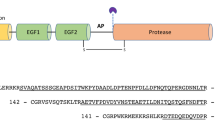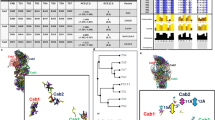Abstract
In a calcium-dependent interaction critical for blood coagulation, vitamin K–dependent blood coagulation proteins bind cell membranes containing phosphatidylserine via γ-carboxyglutamic acid–rich (Gla) domains. Gla domain–mediated protein-membrane interaction is required for generation of thrombin, the terminal enzyme in the coagulation cascade, on a physiologic time scale. We determined by X-ray crystallography and NMR spectroscopy the lysophosphatidylserine-binding site in the bovine prothrombin Gla domain. The serine head group binds Gla domain–bound calcium ions and Gla residues 17 and 21, fixed elements of the Gla domain fold, predicting the structural basis for phosphatidylserine specificity among Gla domains. Gla domains provide a unique mechanism for protein-phospholipid membrane interaction. Increasingly Gla domains are being identified in proteins unrelated to blood coagulation. Thus, this membrane-binding mechanism may be important in other physiologic processes.
This is a preview of subscription content, access via your institution
Access options
Subscribe to this journal
Receive 12 print issues and online access
$189.00 per year
only $15.75 per issue
Buy this article
- Purchase on Springer Link
- Instant access to full article PDF
Prices may be subject to local taxes which are calculated during checkout




Similar content being viewed by others
References
Furie, B. & Furie, B.C. The molecular basis of blood coagulation. Cell 53, 505–518 (1988).
Kalafatis, M., Egan, J., Veer, C.V.T., Cawthern, K. & Mann, K.G. The regulation of clotting factors. Crit. Rev. Eukaryot. Gene Expr. 7, 241–280 (1997).
Zwaal, R.F., Comfurius, P. & Bevers, E.M. Lipid-protein interactions in blood coagulation. Biochim. Biophys. Acta 1376, 433–453 (1998).
Stenflo, J. Contributions of Gla and EFG-like domains to the function of vitamin K-dependent coagulation factors. Crit. Rev. Eukaryot. Gene Expr. 9, 59–88 (1999).
Nelsestuen, G.L., Shah, A.M. & Harvey, S.B. Vitamin K-dependent proteins. Vitam. Horm. 58, 355–389 (2000).
Rosing, J., Tans, G., Govers-Riemslag, J.W.P., Zwaal, R.F. & Hemker, H.C. The role of phospholipids and factor Va in the prothrombinase complex. J. Biol. Chem. 255, 274–283 (1980).
Soriano-Garcia, M., Padmanabhan, K., de Vos, A.M. & Tulinsky, A. The Ca2+ ion and membrane binding structure of the Gla domain of Ca-prothrombin fragment 1. Biochemistry 31, 2554–2566 (1992).
Freedman, S.J., Furie, B.C., Furie, B. & Baleja, J.D. Structure of the calcium ion-bound γ-carboxyglutamic acid-rich domain of Factor IX. Biochemistry 34, 12126–12137 (1995).
Sunnerhagen, M. et al. Structure of the Ca2+-free Gla domain sheds light on membrane binding of blood coagulation proteins. Nat. Struct. Biol. 2, 504–509 (1995).
Banner, D.W. et al. The crystal structure of the complex of blood coagulation factor VIIa with soluble tissue factor. Nature 380, 41–46 (1996).
Li, L. et al. Refinement of the NMR solution structure of the γ-carboxyglutamic acid domain of coagulation Factor IX using molecular dynamics simulation with initial Ca2+ positions determined by a genetic algorithm. Biochemistry 36, 2132–2138 (1997).
Mizuno, H., Fujimoto, Z., Atoda, H. & Morita, T. Crystal structure of an anticoagulant protein in complex with the Gla domain of factor X. Proc. Natl. Acad. Sci. USA 98, 7230–7234 (2001).
Park, C.H. & Tulinsky, A. Three-dimensional structure of the kringle sequence: structure of prothrombin fragment 1. Biochemistry 25, 3977–3982 (1986).
Freedman, S.J., Furie, B.C., Furie, B. & Baleja, J.D. Structure of the metal-free γ-carboxyglutamic acid-rich membrane binding region of Factor IX by 2D NMR spectroscopy. J. Biol. Chem. 270, 7980–7987 (1995).
Zhang, L. & Castellino, F.J. The binding energy of human coagulation Protein C to acidic phospholipid vesicles contains a major contribution from leucine 5 in the γ-carboxyglutamic acid domain. J. Biol. Chem. 269, 3590–3595 (1994).
Christiansen, W.T. et al. Hydrophobic amino acid residues of human anticoagulation protein C that contribute to its functional binding to phospholipid vesicles. Biochemistry 34, 10376–10382 (1995).
Freedman, S.J. et al. Identification of the phospholipid binding site in the vitamin K-dependent blood coagulation protein Factor IX. J. Biol. Chem. 271, 16227–16236 (1996).
Falls, L.A., Furie, B.C., Jacobs, M., Furie, B. & Rigby, A.C. The ω-loop region of the human prothrombin γ-carboxyglutamic acid domain penetrates anionic phospholipid membranes. J. Biol. Chem. 276, 23895–23902 (2001).
Brunger, A.T. et al. Crystallography & NMR system: a new software suite for macromolecular structure determination. Acta Crystallogr. D 54, 905–921 (1998).
Yamazaki, T., Pascol, S.M., Singer, A.V., Forman-Kay, J.D. & Kay, L.E. NMR pulse schemes for the sequence-specific assignment of arginine guanidino 15N and 1H chemical shifts in proteins. J. Amer. Chem. Soc. 117, 3556–3564 (1995).
Leszczynski, J.F. & Rose, G.D. Loops in globular proteins: a novel category of secondary structure. Science 234, 849–855 (1986).
Thariath, A. & Castellino, F.J. Highly conserved residue arginine-15 is required for the Ca2+-dependent properties of the γ carboxyglutamic acid domain of human anticoagulation protein C and activated protein C. Biochem. J. 322, 309–315 (1997).
Lu, Y. & Nelsestuen, G.L. Dynamic features of prothrombin interaction with phospholipid vesicles of different size and composition: implications for protein-membrane contact. Biochemistry 35, 8193–8200 (1996).
Resnick, R.M. & Nelsestuen, G.L. Prothrombin-membrane interaction. Effects of ionic strength, pH and temperature. Biochemistry 19, 3028–3033 (1980).
Evans, T.C. & Nelsestuen, G.L. Importance of cis-proline 22 in the membrane-binding conformation of bovine prothrombin. Biochemistry 35, 8210–8215 (1996).
Perera, L., Darden, T.A. & Pedersen, L.G. Trans-cis isomerization of proline 22 in bovine prothrombin fragment 1: a surprising result of structural characterization. Biochemistry 37, 10920–10927 (1998).
Sommerville, L.E., Resnick, R.M., Thomas, D.D. & Nelsestuen, G.L. Terbium probe of calcium-binding sites on the prothrombin-membrane complex. J. Biol. Chem. 261, 6222–6229 (1986).
Nelsestuen, G.L. & Lim, T.K. Interaction of prothrombin and blood-clotting factor X with membranes of varying composition. Biochemistry 16, 4172–4179 (1977).
Evans, T.C. & Nelsestuen, G.L. Calcium and membrane-binding properties of monomeric and multimeric annexin II. Biochemistry 33, 13231–13238 (1994).
McDonald, J.F. et al. Comparison of naturally occurring vitamin K-dependent proteins: correlations of amino acid sequences and membrane binding properties suggests a membrane contact site. Biochemistry 36, 5120–5127 (1997).
Swairjo, M.A., Concha, N.O., Kaetzel, M.A., Dedman, J.R. & Seaton, B.A. Ca2+-bridging mechanism and phospholipid head group recognition in the membrane-binding protein annexin V. Nat. Struct. Biol. 2, 968–974 (1995).
Verdaguer, N., Corbalan-Garcia, S., Ochoa, W.F., Fita, I. & Gomez-Fernandez, J.C. Ca2+ bridges the C2 membrane-binding domain of protein kinase Cα directly to phospatidylserine. EMBO J. 18, 6329–6338 (1999).
Otwinowski, Z. & Minor, W. Processing of X-ray diffraction data collected in oscillation mode. Methods Enzymol. 276, 307–326 (1997).
Navaza, J. AMoRe: an automated package for molecular replacement. Acta Crystallogr. A 50, 157–163 (1994).
Read, R.J. Improved Fourier coefficients for maps using phases from partial structures with errors. Acta Crystallogr. A 42, 140–149 (1986).
Jones, T.A. & Kjeldgaard, M. O—The Manual (Uppsala, Sweden, 1992).
Brunger, A.T., Krukowski, A. & Erickson, J.W. Slow-cooling protocols for crystallographic refinement by simulated annealing. Acta Crystallogr. A 46, 585–593 (1990).
Blostein, M.D., Rigby, A., Jacobs, M., Furie, B.C. & Furie, B. The Gla domain of human prothrombin has a binding site for factor Va. J. Biol. Chem. 275, 38120–38126 (2000).
Bax, A., Ikura, M., Kay, L., Torchia, D. & Tschudin, R. Comparison of different modes of 2-dimensional reverse-correlation NMR for the study of proteins. J. Magn. Reson. 86, 304–318 (1990).
Zhang, O., Kay, L.E., Olivier, J.P. & Forman-Kay, J.D. Backbone 1H and 15N resonance assignments of the N-terminal SH3 domains of drk in folded and unfolded states using enhanced-sensitivity pulsed field gradient NMR techniques. J. Biomol. NMR 4, 845–858 (1994).
Wishart, D.S. et al. 1H, 13C, 15N chemical shift referencing in biomolecular NMR. J. Biomol. NMR 6, 135–140 (1995).
Kraulis, P.J. MOLSCRIPT: a program to produce both detailed and schematic plots of protein structures. J. Appl. Crystallogr. 24, 946–950 (1991).
Esnouf, R.M. An extensively modified version of MolScript that includes greatly enhanced coloring capabilities. J. Mol. Graph. Model. 15, 132–134 (1997).
Merrit, E.A. & Murphy, M.E.P. Raster3D Version 2.0, a program for photorealistic molecular graphics. Acta Crystallogr. D 50, 869–873 (1994).
Nicholls, A., Sharp, K.A. & Honig, B. Protein folding and association: insights from the interfacial and thermodynamic properties of hydrocarbons. Proteins 11, 281–296 (1991).
Acknowledgements
We thank Brookhaven National Laboratories for time on beamlines X12C, X8C and X25 and J. Wang for assistance with collection of X-ray data. This work was supported by grants from the US National Institutes of Health to B.C.F., B.S., B.F. and M.A.G. and from the American Heart Association to A.C.R.
Author information
Authors and Affiliations
Corresponding author
Ethics declarations
Competing interests
The authors declare no competing financial interests.
Rights and permissions
About this article
Cite this article
Huang, M., Rigby, A., Morelli, X. et al. Structural basis of membrane binding by Gla domains of vitamin K–dependent proteins. Nat Struct Mol Biol 10, 751–756 (2003). https://doi.org/10.1038/nsb971
Received:
Accepted:
Published:
Issue Date:
DOI: https://doi.org/10.1038/nsb971
This article is cited by
-
Phosphatidylserine in the Nervous System: Cytoplasmic Regulator of the AKT and PKC Signaling Pathways and Extracellular “Eat-Me” Signal in Microglial Phagocytosis
Molecular Neurobiology (2023)
-
The role of phosphatidylserine on the membrane in immunity and blood coagulation
Biomarker Research (2022)
-
Human endothelial cells and fibroblasts express and produce the coagulation proteins necessary for thrombin generation
Scientific Reports (2021)
-
Coagulation factor IX analysis in bioreactor cell culture supernatant predicts quality of the purified product
Communications Biology (2021)
-
The Multifaceted Roles of TAM Receptors during Viral Infection
Virologica Sinica (2021)



